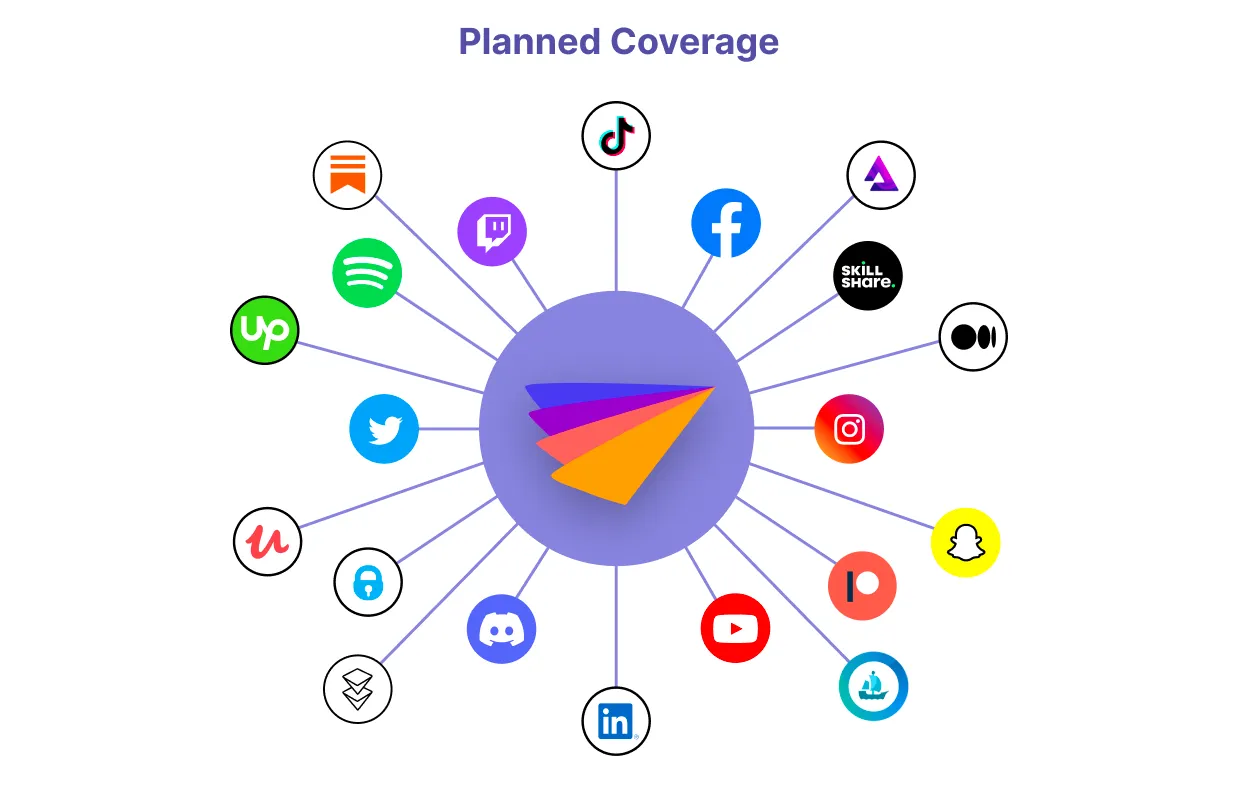Every sunrise is an opportunity for developers to create something that is yet to be explored, to make life better for thousands of people. Today, this is especially true for a rapidly growing landscape such as the creator economy.
Building for this space means building your toolkit too. And one of the most necessary things to build anything today is an API.
While the technical definition of an API is a lot more nuanced, ‘modern APIs’ are essentially interfaces that let two software applications 'talk' to each other, usually over the web/internet. This enables the two applications to be able to use each other's features.
Modern APIs are the building blocks of the modern internet. They let programmers access a wide variety of products and services from other developers or companies without having to write all that code themselves.
APIs are how Amazon connects with logistics partners to deliver packages overnight, how Spotify connects with your Google account to play songs inside the Google Maps app, and how you pay your bills online without standing in queues or mailing in checks.
APIs unlock the true power of the ‘internet’ — by connecting to a network, you can start using that network's resources and expertise, exchange data, and do a lot more.
Naturally, APIs have grown to become the lifeline of the modern digital infrastructure, including the creator ecosystem. And of the many different kinds of APIs needed, social media APIs are of prime importance in this space.
What are social media APIs?

Social media APIs enable third-party developers to build applications on top of a social media platform. They are a way to access the data and functionality of these platforms and use them in your own applications.
The main benefit of using social media APIs is that you can access your user's consented data present on these platforms. This can be useful in a number of ways including -
- Tracking your user's social media activity
- Using your user's social media data to connect effectively
- Allowing your users to post on social media platforms without leaving your app
It allows you to enable social experiences right within your application, which is the most important aspect of serving a social media-savvy user in today's world (which, frankly, everyone is).
However, integrating these social media APIs into your product can be quite a task. Added to that, there are hundreds of social media platforms out there, each with its own set of API rules and protocols for integrations.
So should you be building these API integrations in-house? Or should you just outsource it? Or find a solution that you can buy?
There are many ways to approach the API problem in this industry, and depending on your business needs, there may be no single answer that makes sense.
In this article, we’ll go over some key questions you should ask yourself before deciding to build or buy an API integration solution for your creator economy product.
When to build a social media API integration solution?
1. Does your feature/MVP get enough traction?
When deciding whether or not to build or buy an API, the first question to ask yourself is: “Does my MVP get enough traction?”
If so, it might be worth building it. Today, we have so many social media platforms - all contributing to the growth of the creator economy. But managing each platform API becomes a challenge, and you might want to buy an integrated API solution - one API for all platforms.
After all, building an API solution isn’t cheap — it can cost tens of thousands of dollars and take months.
TL;DR - Consider building an API infrastructure when your feature/MVP has got enough traction and you wish to double down on it.
2. Do you have the resources and bandwidth?
Building an API integration requires time and effort from your team. Also, as mentioned earlier, different creator platforms have different protocols and guidelines to follow.
And more often than not, the first version built will almost always be far from perfect and require lots of improvements. So, you need to factor in any potential bugs or issues that might arise while building out the API integration solution as well.
If your company has a strong engineering team, you may go ahead with building your own social media API integrations. But remember, it makes sense to do this when you only have to integrate and maintain one or two platform APIs. If you have to maintain connections with tens or hundreds of such platforms, integrating and maintaining so many APIs becomes a huge challenge.
TL;DR - Building an API integration is the best option when you have significant engineering and product resource availability and a willingness to have a longer GTM cycle.
3. Do you need a very custom solution?
Suppose your product has specific needs that an off-the-shelf solution can't meet. In that case, you should consider building something custom for your business — or something more advanced than most API solutions readily available.
You'll also want to build if you need access to sensitive data or want fine-grained control over how and when your data is used. Remember, if you're building a social media data infrastructure for your business, ensuring that data API is a vital part of your product strategy is essential.
TL;DR - If your API integration solution needs to be highly customized, then it may be better to build it yourself.
When to buy a social media API integration solution?
1. Are you building/testing a new feature/MVP?
Let’s say you’ve got an idea for a new feature, but you’re not sure if it will work. You want to build or test it before going all-in on your idea. Maybe you have an MVP that has already been built, but you want to know if there is any interest in the market.
Then, it’s not worth using all your energy on building. You can instead just buy an existing solution and test out the waters.
2. Do you have limited engineering and product resources?
If your company has limited engineering resources, it can be hard to build complex API integrations for different social media platforms to meet your needs. If your team doesn't have significant experience integrating social media APIs, it can be hard to know how long it will take or what resources are required.
Even if you have some engineers on hand who have done this kind of work before, they may not be able to help because they're busy working on other things — like fixing bugs in your existing product!
3. Do you have fast GTM timelines to adhere to?
If you don't have a lot of time before you need to roll out your new feature or product, then there is no reason to build extensive API integration solutions. After all, there are so many other options available.
Your time is better spent on other things that will advance your business than building an API integration from scratch.
4. Is there a market solution already available?
The API market is mature, with plenty of solutions available for nearly every use case. You can find APIs for everything from payments and authentication to content management and analytics.
In most cases, you’ll be able to leverage the pre-existing solutions - either out of the box or with minimal customization.
5. Is the proposed solution core to your business?
If it's not, then you can instead buy the expertise.
However, there’s another thing to consider here. Even if it were your core feature, it also depends on whether that is the core business value your customers get.
Think about it this way. Let’s say what you’re currently building is, in fact, your core product/feature.
But does it necessarily mean you should build the API integrations?
Maybe not, because there are so many platforms you’ll have to integrate then.
While building an API integration, the product development team will have to evaluate their priorities carefully. They should spend their time on things that make them money, like improving the product's user experience.
Also, it’s usually tough for a company to understand all the different technologies required to integrate multiple social media APIs. You need to know about authentication, data mapping, rate limiting, security, and more.
Moreover, you are in the business of helping creators grow. So your priority will most definitely be to build new tools and features that help creators, not build the entire data infrastructure for it.
So, buying a social media API integration solution makes much more sense. It allows you to focus on the value you’ll deliver to your users - creators - rather than spending time and effort building and managing different APIs.
Check out Phyllo APIs that empower the creator economy

Phyllo is an API gateway to access creator and independent work platforms (e.g., YouTube, Instagram, Twitch, TikTok, Shopify, Upwork, and more). Using Phyllo, developers can access creators,' and independent workers' consented data directly from source platforms.
Instead of thousands of developers building their integrations with YouTube, TikTok, Patreon, Spotify, and Instagram and then maintaining and troubleshooting them, Phyllo helps simplify and package this process into a single easy-to-integrate API.
Phyllo provides multiple benefits over developers building custom integrations with each platform separately. If you’re thinking of building such integrations on your own or have already built such integrations, the following pointers can help you make more informed decisions -
Distribution
With the rapidly evolving creator economy, platforms are also seeing a tectonic shift.
Earlier, building for this economy meant integrating with just Instagram or YouTube. However, today, multiple platforms, including TikTok, Twitter, Twitch, Pinterest, Discord, Substack, LinkedIn, OnlyFans, Spotify, Cameo, and more, are all equally important - which means more custom integrations!
And so, you either spend a lot of engineering bandwidth on integrating with platforms you are not sure will give returns or live with the risk of losing out to creators.
Currently, at Phyllo, we provide coverage across Instagram, Youtube, Facebook, TikTok, Twitch, Twitter, Pinterest, Discord, Substack, Shopify, Patreon, and more.
Check out platforms covered by Phyllo here.

Time to go live
Building such custom integrations can be a multi-step process, which includes -
- Use Case Definition
- Platform and Doc Research
- Data Normalization (this is very important unless you want to limit yourself to a few platforms)
- App Engineering
- App Approval from the source
Depending upon the size of the organization and use cases, this process can take months, if not quarters. And then, you will need to repeat it every time you integrate a new platform!
Furthermore, most of the source platforms do not provide you with webhooks. So, to get the platform data, you will have to build a robust polling mechanism to poll data from platform APIs at a regular frequency.
Building such a mechanism can again be quite a significant investment with increased complexity due to platform rate limits, quota limits, and getting content for disappearing posts such as Insta Stories.
At Phyllo, since we already have this engine, we poll the data at regular intervals throughout the day based on our smart systems. This guarantees at least one update in 24 hours and more for ephemeral data like Insta stories. We then notify you via webhooks whenever we see a change in any of the metrics.
Creator account connection experience
We understand user experience is paramount.
At Phyllo, we’re constantly learning, re-learning, and improving. We ensure to aggregate our learnings from various client experiences and implementations to create the best creator account connection flow.
Hence, a few things you get out of the box with Phyllo are -
- Suitable Disclosure Messaging to encourage creators to connect their accounts. We refine this based on creator feedback and what assures them the most.
- Data Consent Mechanism compliant as per GDPR, CCPA, and every primary data privacy law.
- Refined UX to onboard creators in complex onboarding journeys such as Instagram account connection that requires you to have a creator account.
- Information handling: Error messages, account disconnections, connection failures, and many other scenarios improve the creator’s conversion frequency.
Cost of ongoing maintenance
Social/creator platform integrations need constant maintenance. There can be changes in the platform's API, ongoing integration issues, debugging, and support requirements. Also, at times, the platform teams would want to audit your apps, data policies, etc.
With Phyllo APIs, you delegate maintenance to our web services, where we promise your uptimes, support SLA, and enhance the product with the evolving source platforms.
Security and scalability
As a creator business, your prime focus is to build the winning features that your customer/creators will love. And in this race of building the most desired creator product, the additional burden of building the data infrastructure can be a distraction.
Yet, if you are building this yourself, you will need to plan around data security, managing scale through the data pipes, and rate and quota limits of source platforms.
Phyllo stresses and strives to get this creator data in a safe, efficient, and trustable manner; we spend a lot of time and energy on ensuring data security and scale. We employ the necessary best practices, monitoring tools, and encryption protocols. We get vulnerability assessments and engineer our system on a massive scale.
Wrapping up
All companies face the build vs. buy dilemma. Many may consider building their own API integrations. However, as discussed, building an API solution from scratch is not easy.
This is precisely why we built (and continue to build) Phyllo. We want you to get continuous access to verified, creator-consented data across hundreds of platforms without much hassle so you can focus on building your product to empower this new and budding ecosystem.
Schedule a call with us to learn more about how Phyllo can empower your business in the creator economy.
Want to test the waters before you go ahead? Sign up for a free account to access creator data with Phyllo APIs.









